Road signs in Canada
Road signs in Canada may conform to the Manual of Uniform Traffic Control Devices for Canada (MUTCDC)[1] by the Transportation Association of Canada (TAC)[2] for use by Canadian jurisdictions. Although it serves a similar role to the MUTCD from the US Federal Highway Administration, it has been independently developed and has a number of key differences with its American counterpart, most notably the inclusion of bilingual (English/French) signage for jurisdictions such as New Brunswick with significant anglophone and francophone population, and a much heavier reliance on symbols rather than text legends.
The Ministry of Transportation of Ontario (MTO) also has historically used its own MUTCD which bore many similarities to the TAC MUTCDC. However, as of approximately 2000, MTO has been developing the Ontario Traffic Manual (OTM), a series of smaller volumes each covering different aspects of traffic control (e.g., regulatory signs, warning signs, sign design principles, traffic signals, etc.).
Language
Signs for the most part employ two languages, English, French or both. However, some signs are trilingual, incorporating English, French and an indigenous language such as Cree.
Stop sign
In Quebec, Canada, modern signs read either arrêt or stop,[3] however it is not uncommon to see older signs containing both words in smaller lettering, with arrêt on top.[4] Both stop and arrêt are considered valid French words and the Office québécois de la langue française (OQLF) notes that the use of "stop" on stop signs is attested in French since 1927.[5] In practice, however, it can be empirically observed (for instance, with Google Street View) that "arrêt" predominates in French-speaking areas (i.e., most of the geographic extent of Québec), while "stop" can be found in majority English-speaking areas such as Montreal's West Island suburbs. At the time of the debates surrounding the adoption of the Charter of the French Language ("Bill 101") in 1977, the usage of "stop" on the older dual-word signs was considered to be English and therefore controversial; some signs were occasionally vandalized with red spray paint to turn the word stop into "101".[6] However, it was later officially determined by the OQLF that "stop" is a valid French word in this context, and the older dual arrêt + stop usage is therefore not considered bilingual but merely redundant and therefore deprecated (à éviter). All newly installed signs thus use either one word or the other, but not both.
The province of New Brunswick has bilingual stop arrêt in English-speaking areas. Acadian regions of Nova Scotia and Prince Edward Island also have bilingual signs. Some areas in Manitoba and Ottawa, Ontario also have bilingual signs. Entry points to the country through Canada Customs also have bilingual stop signs. On First Nations or Inuit territories, stop signs sometimes use the local aboriginal language in addition to or instead of English and/or French. Other parts of Canada use stop.
Canadian road signs
The following are samples of Canadian road signs.
Gallery
-

Stop sign (English)
-
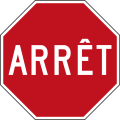
Stop sign (French)
-
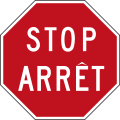
Stop sign (English and French)
-

Stop sign (French and English)
-
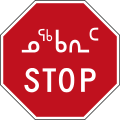
Stop sign (Inuktitut and English)
-

Stop Ahead
-

Yield sign
-

Yield at Roundabout
-
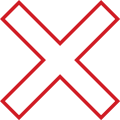
Railway Crossing
-
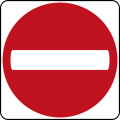
Do Not Enter
-

No Stopping
-
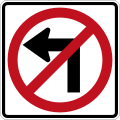
No Left Turn
-
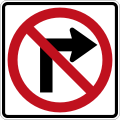
No Right Turn
-
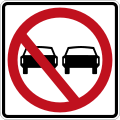
No Overtaking
-
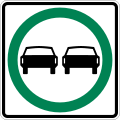
Overtaking Permitted
-
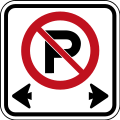
No Parking
-
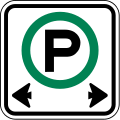
Parking Permitted
-

Dangerous Goods Vehicles Prohibited
-

Route for Dangerous Goods Vehicles
-

No Littering
-

Shared Path
-

Bike Lane
-

Bus Lane
In Quebec taxis are often included and thus shown and as well as time periods in force In Quebec bus and taxi are spelled out, see below -

Road sign used in British Columbia, Canada, near the Canada–US border to remind American drivers that Canada uses the metric system.
Note that the imperial speed limit (left) is shown using a Canadian-style sign, rather than an MUTCD-standard one as would be used in the US
Québec road signs
The following are samples of Québec road signs.[7][8][9]
Québec gallery
-

-
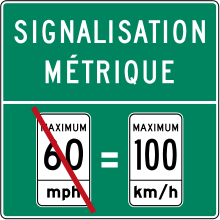
Metric signage reminder in Quebec, posted near US border
-
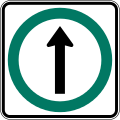
Québec, Go straight only, No other turns permitted
-
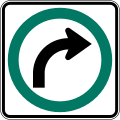
Québec, Turn right only, No other turns permitted
-

Québec, Turn left only, No other turns permitted
-

Québec, Go straight or turn left only, No other turn permitted
-
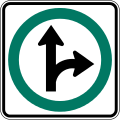
Québec, Go straight or turn right only, No other turn permitted
-
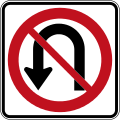
Québec, No U turn
-

Québec, No right turn
-
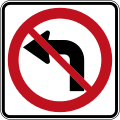
Québec, No left turn
-

Québec, Except authorized vehicles
-

Québec, Except bus(es)
-

Québec, Except bicycles
-

Québec, (French language version of the 24 hour clock) 08:00 - 19:00 Mon(day) to Fri(day)
-
.svg.png)
06:30 -09:00, 15:30 - 18:30, Mon(day) to Fri(day)
-

MAXIMUM 100 (km/h)
References
| Wikimedia Commons has media related to Road signs in Canada. |
- ↑ Manual of Uniform Traffic Control Devices for Canada (Fifth ed.). Ottawa: Transportation Association of Canada. 2014. PTM-MUTCD14-E (English ed.). External link in
|publisher=(help) - ↑ TAC
- ↑ "Répertoire des dispositifs de signalisation routière du Québec, Transports Québec". Mtqsignalisation.mtq.gouv.qc.ca. Retrieved 2012-03-11.
- ↑ "Canada, Quebec, Montreal, bilingual Stop sign Stock Photos". Masterfile.com. Retrieved 2012-03-11.
- ↑ Office québécois de la langue française, granddictionnaire.com. No direct link: look up "panneau STOP" under "Recherche" and then click on either "route" or "transport" under the resulting "Index" listing
- ↑ Photo by Flickr.com user "imagesdistributioncanada"
- ↑ Tous les dispositifs de signalisation
- ↑ Road_signs_of_Quebec
- ↑ Road_signs_of_Quebec
